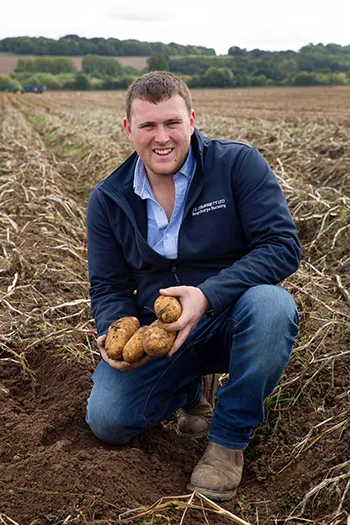Innovating in farming to harvest tonnes of goodness
Growing potatoes isn’t something you do overnight. It’s an intensive process that requires constant management. At Staythorpe Farming, Tom grows different varieties of potato with the support of Lamb Weston, and because innovating in farming plays a big role in optimising the growing process, knowledge is shared to decide where to look for new opportunities. With Lamb Weston's potato supply accounting for 50% of their carbon emissions, growers like Tom can have a significant impact on sustainability in the chain. As part of an equal relationship, it’s only fair to strive towards such goals together.
Innovating in farming for fries
So, what’s it like to grow fries? “Well, I’m a farmer through and through!” Tom laughs. “We grow wheat, maize, barley and beans, as well as Innovator, Challenger, Fontane, and Markies potatoes! These are all particularly lengthy varieties of potato that can be used to make long fries.”
Season-round innovation
“Since we’ve started growing for Lamb Weston, we’ve actually adopted a range of new practices in supplying potatoes to the business,” Tom explains. “They listen to us, and we get information from them, which makes for a valuable partnership.”
In farming, innovation needs to go hand in hand with seasonal change. It’s important to know what works in order to make sure that we can grow and harvest enough potatoes. “We started with drip irrigation, which is a way of feeding water directly to the roots of the crops, this uses much less water than other, more conventional irrigation techniques. Currently, we’re also working on implementing more cover cropping before planting the seed potatoes and humidified storage for after the harvest. During the harvest, we also use ‘jumbo bag trailers’, an innovation that minimises potato handling to help eliminate defects whilst also reducing the impact on our soil.”
Cover cropping involves planting crops such as mustards or radishes before the potatoes and these are then incorporated into the soil in the Spring to reduce disease pressure on the potatoes when they are growing. Humidified storage helps maintain the quality of the stored potatoes, reducing weight loss and therefore bruising.
Ultimately, all of these innovations support more efficient use of resources whilst also allowing Lamb Weston to continue to supply high-grade, consistent frozen potato products to their Foodservice customers.

Image: Tom Burnett
Future-proof food
Tom’s business continues to evolve. “It’s necessary,” he says, “as we are likely to see more extreme weather events, such as longer, drier, hotter periods and prolonged spells of rain. If we don’t continue to grow and work in a sustainable fashion, we won’t survive in the future. Innovation helps to mitigate risks and work more efficiently while reducing the impact of the food we produce. This will also reduce our carbon emissions and mean we produce less waste in everything we do!”
By managing our soil more carefully, using our inputs more efficiently, and potentially using less of them, the carbon footprint of each tonne of fries we supply will be reduced. That way, Foodservice professionals can serve their customers fries and other potato products that give them peace of mind and are packed with goodness!
Bitesize fact
A Lamb Weston potato is always local. That’s because every growing area has a factory nearby, ready to turn the potato into frozen packed potato solutions.
Hungry for more?
In Eat This! Magazine you’ll find the latest trends, inspiration, and expert advice. Download your free copy now!